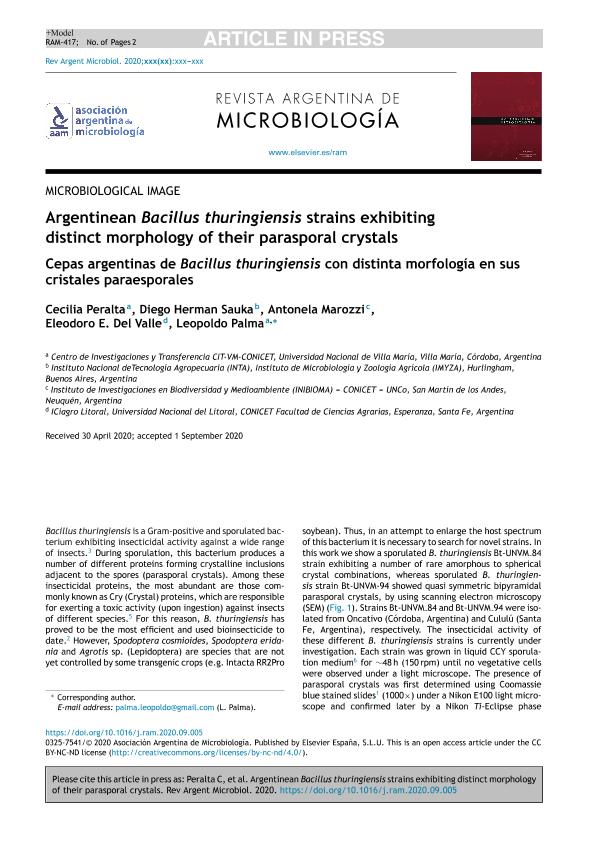Artículo
Argentinean Bacillus thuringiensis strains exhibiting distinct morphology of their parasporal crystals
Título:
Cepas argentinas de Bacillus thuringiensis con distinta morfología en sus cristales paraesporales
Peralta, Cecilia ; Sauka, Diego Herman
; Sauka, Diego Herman ; Marozzi, Antonela Alejandra
; Marozzi, Antonela Alejandra ; del Valle, Eleodoro Eduardo
; del Valle, Eleodoro Eduardo ; Palma, Leopoldo
; Palma, Leopoldo
 ; Sauka, Diego Herman
; Sauka, Diego Herman ; Marozzi, Antonela Alejandra
; Marozzi, Antonela Alejandra ; del Valle, Eleodoro Eduardo
; del Valle, Eleodoro Eduardo ; Palma, Leopoldo
; Palma, Leopoldo
Fecha de publicación:
12/11/2020
Editorial:
Asociación Argentina de Microbiología
Revista:
Revista Argentina de Microbiología
ISSN:
0325-7541
e-ISSN:
1851-7617
Idioma:
Español
Tipo de recurso:
Artículo publicado
Clasificación temática:
Resumen
Bacillus thuringiensis is a Gram-positive and sporulated bacterium exhibiting insecticidal activity against a wide range of insects.3 During sporulation, this bacterium produces a number of different proteins forming crystalline inclusions adjacent to the spores (parasporal crystals). Among these insecticidal proteins, the most abundant are those commonly known as Cry (Crystal) proteins, which are responsible for exerting a toxic activity (upon ingestion) against insects of different species.5 For this reason, B. thuringiensis has proved to be the most efficient and used bioinsecticide to date.2 However, Spodoptera cosmioides, Spodoptera eridania and Agrotis sp. (Lepidoptera) are species that are not yet controlled by some transgenic crops (e.g. Intacta RR2Pro soybean). Thus, in an attempt to enlarge the host spectrum of this bacterium it is necessary to search for novel strains. In this work we show a sporulated B. thuringiensis Bt-UNVM_84 strain exhibiting a number of rare amorphous to spherical crystal combinations, whereas sporulated B. thuringiensis strain Bt-UNVM-94 showed quasi symmetric bipyramidal parasporal crystals, by using scanning electron microscopy (SEM) (Fig. 1). Strains Bt-UNVM_84 and Bt-UNVM_94 were isolated from Oncativo (Córdoba, Argentina) and Cululú (Santa Fe, Argentina), respectively. The insecticidal activity of these different B. thuringiensis strains is currently under investigation. Each strain was grown in liquid CCY sporulation medium6 for ∼48 h (150 rpm) until no vegetative cells were observed under a light microscope. The presence of parasporal crystals was first determined using Coomassie blue stained slides1 (1000×) under a Nikon E100 light microscope and confirmed later by a Nikon Ti-Eclipse phase contrast microscope (1000×) (data not shown). For the SEM analysis, aliquots of 1 ml were centrifuged for 5 minutes (16,000 g) at room temperature. Each pellet was washed three times with sterile distilled water and fixed with 100 μl 4% formaldehyde. Each fixed preparation was then sent to Centro Integral de Microscopía Electrónica (CIME ? CONICET ? UNT) for SEM examination.
Palabras clave:
Bacillus thuringiensis
,
Biopesticidas
,
Cristales parasporales
Archivos asociados
Licencia
Identificadores
Colecciones
Articulos(CCT - CORDOBA)
Articulos de CTRO.CIENTIFICO TECNOL.CONICET - CORDOBA
Articulos de CTRO.CIENTIFICO TECNOL.CONICET - CORDOBA
Citación
Peralta, Cecilia; Sauka, Diego Herman; Marozzi, Antonela Alejandra; del Valle, Eleodoro Eduardo; Palma, Leopoldo; Argentinean Bacillus thuringiensis strains exhibiting distinct morphology of their parasporal crystals; Asociación Argentina de Microbiología; Revista Argentina de Microbiología; 247; 12-11-2020; 1-2
Compartir
Altmétricas



